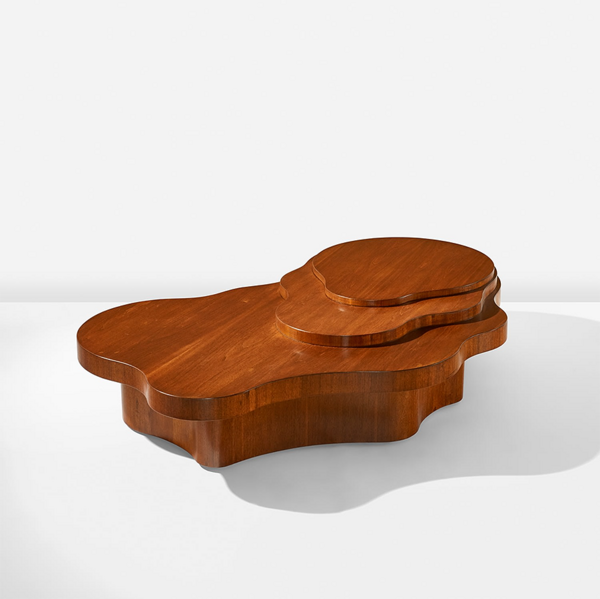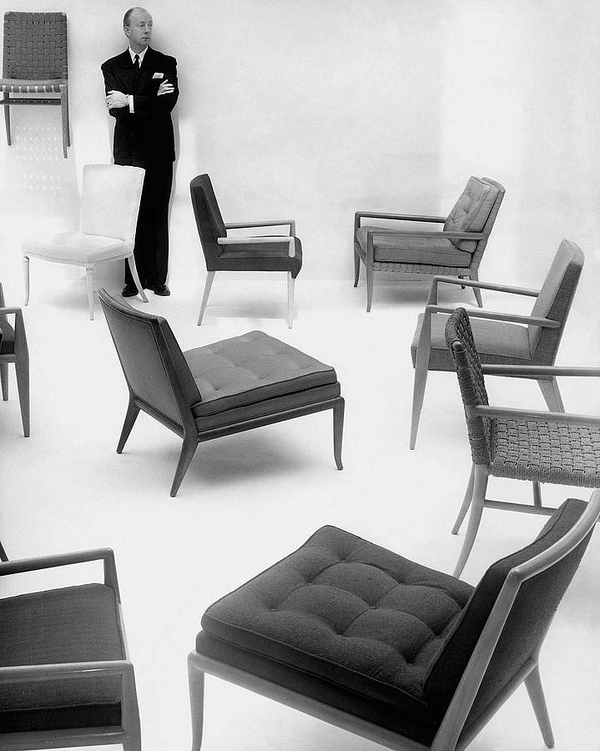Promotional image for The Widdicomb Furniture Company, circa 1952.
Written by Luke Baker
The designer, decorator, and critic Terrence Harold Robsjohn-Gibbings arrived in the United States from England around 1930 to sell European antiques to wealthy Americans as the head of Charles of London’s New York flagship store. However, he would soon find himself soured on the fussy historic imports, brought in by the boatload from dusty dynastic estates across the Atlantic and acquired by a clientele eager to adopt the next trendy revival, from Tudor to tous les Louis.
What began as an aversion to antiques would become Robsjohn-Gibbings’ reformist campaign to develop a true American design idiom for the postwar era, a mission he pursued for the next thirty years through his prolific writings and popular furniture collections for mass manufacturers. Nowhere is this impulse to create a timeless American style more apparent (or successful) than in the spectacular Mesa table from 1952, the most significant and rare of Robsjohn-Gibbings’ designs.
“America has wasted time, money and effort for the last fifty years wistfully recalling the architecture and furniture of Europe,” Robsjohn-Gibbings tartly opined in Goodbye Mr. Chippendale, a 1944 treatise against the devotion to antiques. But contemporary manifestations of European Modernism offered no appealing alternative to such “brown furniture" either. In Homes of the Brave from 1954, he disdained the “spidery metallic seating,” and austere interiors that seemed to prize a progressivist ideology over the comfort of the human bodies that would dare to inhabit them.
T.H. Robsjohn-Gibbings, Mesa coffee table, model no. 1760-6, designed 1952, produced 1953. Design New York.
Rather, Robsjohn-Gibbings saw the end of wartime austerity as an auspicious moment to resurrect the country’s design and manufacturing industries by defining a new domestic aesthetic — one shaped not by past styles or prescriptive philosophies, but by how people actually wanted to live. “In the post-war years that lie ahead, America will be called upon to rehouse and provide furniture for millions of its people,” he wrote in 1944. “So let’s think over the depressing saga that made us into antique collectors and […] examine our own good architecture and the possibilities for good contemporary American furniture.”
Robsjohn-Gibbings did just that, shuttering his successful high-end furniture and decorating business to become the creative director of Grand Rapids-based manufacturer Widdicomb Furniture Company in the early 1940s. For the next decade, he focused on producing collections of well-designed objects intended for middle-class Americans — furniture that celebrated the American values our GIs had fought to defend: democracy, perpetual self-invention, and the freedom to live however we damn well please.
Even among Robsjohn-Gibbings’ 1952 collection for Widdicomb, the Mesa table marks a departure from the norm with its strikingly sculptural form and scale. Many of his furniture designs drew upon the proportions and ancient forms of Antiquity, but Mesa’s novel organic shape was said by the designer to be inspired by the distinctive landforms of the American Southwest, as seen from above. Combined with the topographic effect of its graduated stacked slabs, Mesa is less a table than a geological formation domesticated for the living room. True to Robsjohn-Gibbings’ trademark subtlety, its surface is smooth and unembellished, deliberately free of reference to style or era, with the figure of its native American walnut veneer as its only decoration. As if to further dismiss any association with its predecessors, the table’s stepped horizontal surface sits on a broad and asymmetrical pedestal foot, foregoing the four slender legs of its platonic archetype.
Portrait of T.H. Robsjohn-Gibbings with a selection of his furniture designs, 1947. Photograph by John Rawlings.
Shortly after its debut, the Mesa table was featured on the front of House Beautiful magazine, the exemplification of the cover story on “The luxury of informality.” In the ensuing spreads, readers were introduced to numerous Southwest-inflected interior settings Robsjohn-Gibbings designed for the Widdicomb showroom and appointed with a range of pieces from his most recent collection for the company. Each embodied his conception for a new mode of domesticity that eschewed the stuffiness of tradition and embraced casual comfort, ease, and flexibility. As the centerpiece of the living room, the Mesa table was styled to display the stuff of life — albeit an aspirational one — from pre-Columbian vessels (a nod to indigenous North American aesthetics), to perfume bottles and abstract objets d’art. “We are discovering the simple but forgotten fact that people are most themselves and most interesting when they are comfortable,” the article’s author observed. The Mesa table’s convenience and versatility were key to the American approach to leisure and entertaining. It was a piece designed for serving highballs, poured promptly at five; for displaying full-color magazines, from LIFE to Art and Architecture; for conversationalists to gather around, smoking in low-slung chairs; for after-dinner knitting projects or trays of finger sandwiches.
“The new house and their interiors are the new way of life of a new generation."
— T.H. Robsjohn-Gibbings
Monumental in scale, assertively horizontal, and exuding a rich and natural warmth, the Mesa table is borne of Robsjohn-Gibbings’ humanist ideal for the post-war American home.This wasn’t an object designed for the taught and formal boxes of the Victorian, or the equally constraining and severe “machines for living” espoused by the early 20th century Modernists. “Contemporary houses are the natural development of architecture to meet the changing forms in our social habits and customs,” he noted in Goodbye Mr. Chippendale. As such, Mesa was conceived for a home that invited relaxation and leisure with sweeping, open living spaces. Our houses should be “projections of human personalities and universal human needs, rather than essays in architectural style or theory,” Robsjohn-Gibbings asserted in Homes of the Brave. He went on to praise the “familiarity and architectural unpretentiousness” of the new ranch house typology, that uniquely American vernacular that dominated new home construction after the war, but which traces its lineage to the organic architecture of Frank Lloyd Wright, a designer whom Robsjohn-Gibbings found deeply influential.
The Mesa table is Robsjohn-Gibbings’ crowning achievement in his ambition to develop a design vocabulary authentic to the culture, landscapes, and distinctly individual spirit of his adopted homeland. “The new house and their interiors are the new way of life of a new generation,” he pronounced in 1944. By shaking free the yokes of stylistic pedigree, Mesa was molded instead by the enduring values of comfort, nature, and craftsmanship, boldly signaling a new era with an appropriately timeless form.
Recommended Reading


